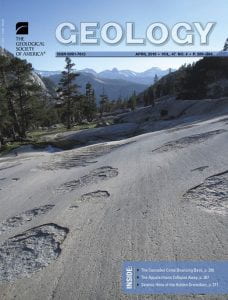The history of subglacial waters and testing the sensitivity of the East Antartica Ice Sheet to global warming
Efforts to improve sea level forecasting on a warming planet have focused on determining the temperature, sea level and extent of polar ice sheets during Earth’s past interglacial warm periods. Large uncertainties, however, in reconstructions of sea level highstands during these past warm periods, as well as in the predictions of future sea level rise, result from the poorly constrained climate sensitivity of the Antarctic Ice sheet. The AIS is the world’s largest freshwater reservoir but to what extent, if any, has the AIS contributed to past Global Mean Sea Level Rise? This question is of particular interest for the Pleistocene, over which global average temperatures reached 1-2 °C above preindustrial averages during each interglacial warm period, conditions analogous to near future climate. Our research aims to develop the use of subglacial precipitates as an archive the past Antarctic ice sheet (AIS) response to climate over Pleistocene interglacial-glacial cycles. These chemical precipitates formed in the past subglacial aquatic environments beneath the AIS as a byproduct of subglacial chemical weathering. These water-lain accumulations of calcite or opal can be dated by 234U-230Th geochronologic methods and their compositions characterized, constraining both the timescale of formation and the compositional history of past subglacial waters. They can form over durations exceeding 105 years before being transported to the surface and deposited in moraines. Ongoing efforts link the changes in subglacial water chemistry and the occurrence of calcite formation with Southern Ocean warming events a link that points to ocean forcing as inducing grounding line migration, ice streaming and subglacial calcite precipitation from subglacial waters.
Marine mineralization and Mammoth tusks
U-Th dating can date the timing of marine minerals including Mn-nodules, black smokers and the occasional mammoth tusk. The Blackburn lab works with the USGS Global Marine Mineral Resources group located in Santa Cruz, CA to constrain the timescales of sub-marine processes.
Composition and formation age of amorphous silica coating glacially polished surfaces
Recent micrographs of smooth, glacially abraded silicic bedrock reveal an amorphous coating layer adhering to the bedrock, with structures that tie its formation to glacial abrasion. What remains unclear is whether this coating is formed by the physical comminution of bedrock, resulting in amorphous material with a bedrock composition, or by chemical dissolution of silicate minerals followed by precipitation of an amorphous layer enriched in silica and depleted in cations relative to the bedrock. In a manuscript from our UCSC team, we report the composition and formation age of the amorphous coatings in Yosemite National Park, California, USA. The coatings are depleted in base cations (50%–90%) and enriched in silica (10%–50%) as well as trace Fe and U (4- to 100-fold) relative to the bedrock, reflecting dissolution by and precipitation from subglacial waters. The 234U/238U activity ratio of the amorphous layer is 200%–600% above secular equilibrium, reflecting a surficial U source enriched by α-recoil processes and consistent with the 234U enrichment observed in subglacial waters. The 230Th/238U activity ratio is 30%–100% below secular equilibrium and records Th-U fractionation in subglacial waters at 30–10 ka, consistent with coating formation during the Last Glacial Maximum (LGM). These amorphous coatings are subglacial precipitates that record the chemical weathering of silicates beneath glaciers during the LGM. Collectively, these observations link silicate dissolution and amorphous silica production to physical processes at the glacier bed, a result that may have significant implications for the global Si and CO2 budgets on glacial-interglacial time scales.
Early Solar System Accretion
Chondritic meteorites (like the LL chondrite shown at left), derived from asteroidal parent bodies and composed of millimeter-sized chondrules, record the early stages of planetary assembly. Yet, the initial planetesimal size distribution and the duration of delay, if any, between chondrule formation and chondrite parent body accretion remain disputed. In Blackburn et al., 2017 we placed constraints on the size, life time and disruption history of the H and L parent bodies. In a recent manuscript by Graduate Student Graham Edwards our team uses Pb-phosphate thermochronology with planetesimal-scale thermal models to constrain the minimum size of the LL ordinary chondrite parent body and its initial allotment of heat-producing 26Al. Bulk phosphate 207Pb/206Pb dates of LL chondrites record a total duration of cooling ≥75 Ma, with an isothermal interior that cools over ≥30 Ma. Since the duration of conductive cooling scales with parent body size, these data require a ≥150-km radius parent body and a range of bulk initial 26Al/27Al consistent with the initial 26Al/27Al ratios of constituent LL chondrules. The concordance suggests that rapid accretion of a large LL parent asteroid occurred shortly after a major chondrule-forming episode.
U-Pb Thermochronology
To provide an enhanced record of lithosphere cooling, a large component of our team's research has worked to develop new analytical and numerical methods to take advantage of the U-Pb system’s dual decay scheme, where parent isotopes 238U and 235U decay at different rates to daughter isotopes 206Pb and 207Pb, respectively. By coupling this dual isotopic system with diffusion’s length scale dependency, which causes different crystal sizes to retain Pb over different absolute time scales, we have been able to demonstrate that a unique time temperature path for a sample can be determined from dating a range of crystal sizes, with each crystal containing its own unique daughter isotopic composition (Blackburn et al., 2011). This technique’s ability to uniquely measure cooling rates can be applied towards solving a number of different problems in the Earth sciences including measuring the long term erosion rates of the continents (Blackburn et al., 2012) or the timing and temperatures of mantle plume heating (Edwards and Blackburn, 2018).




